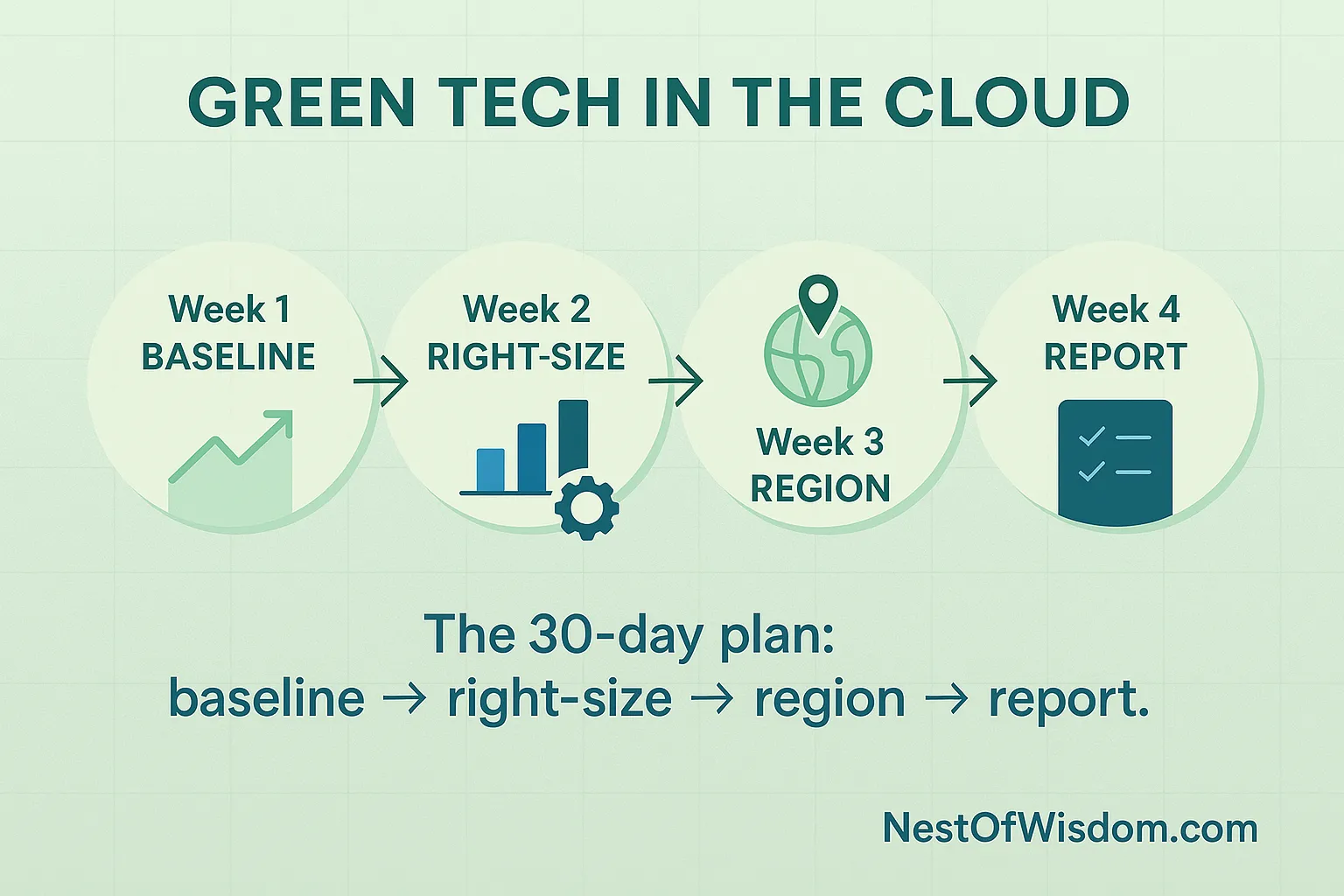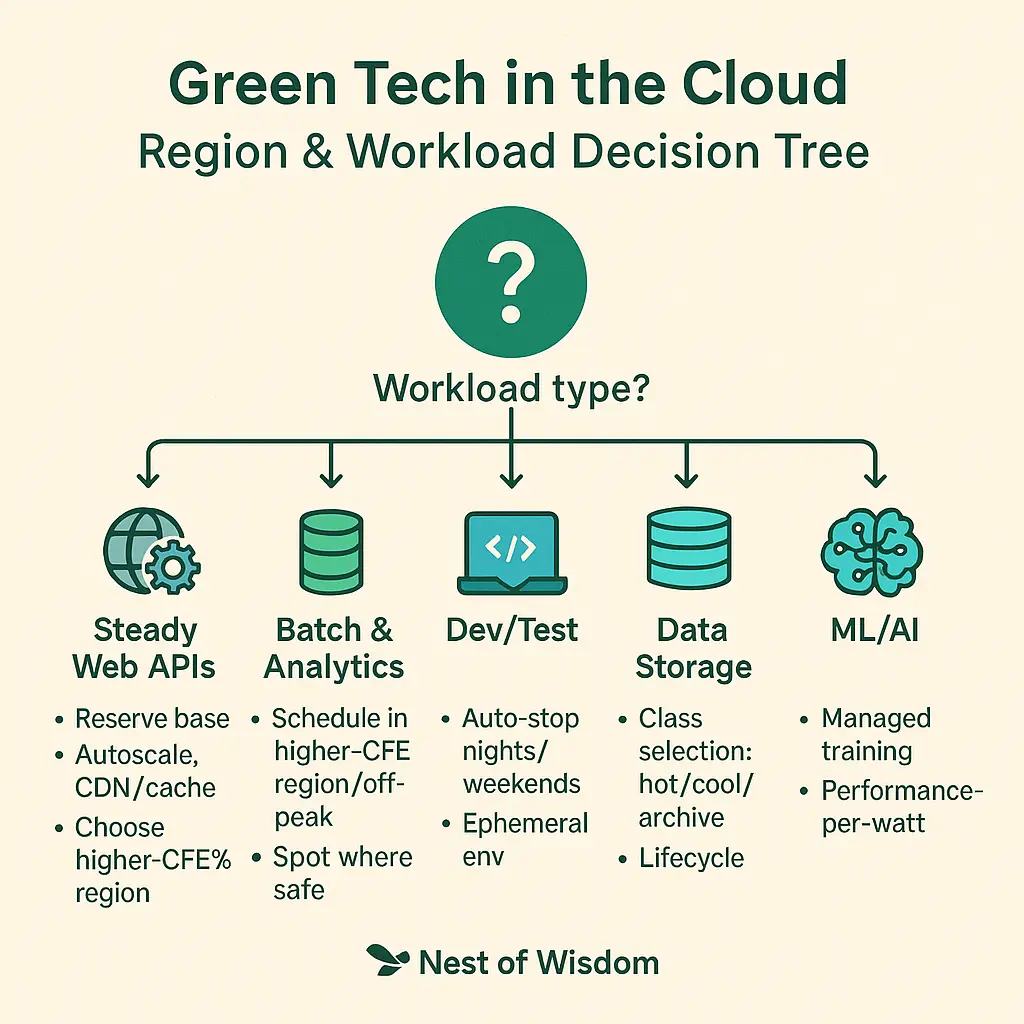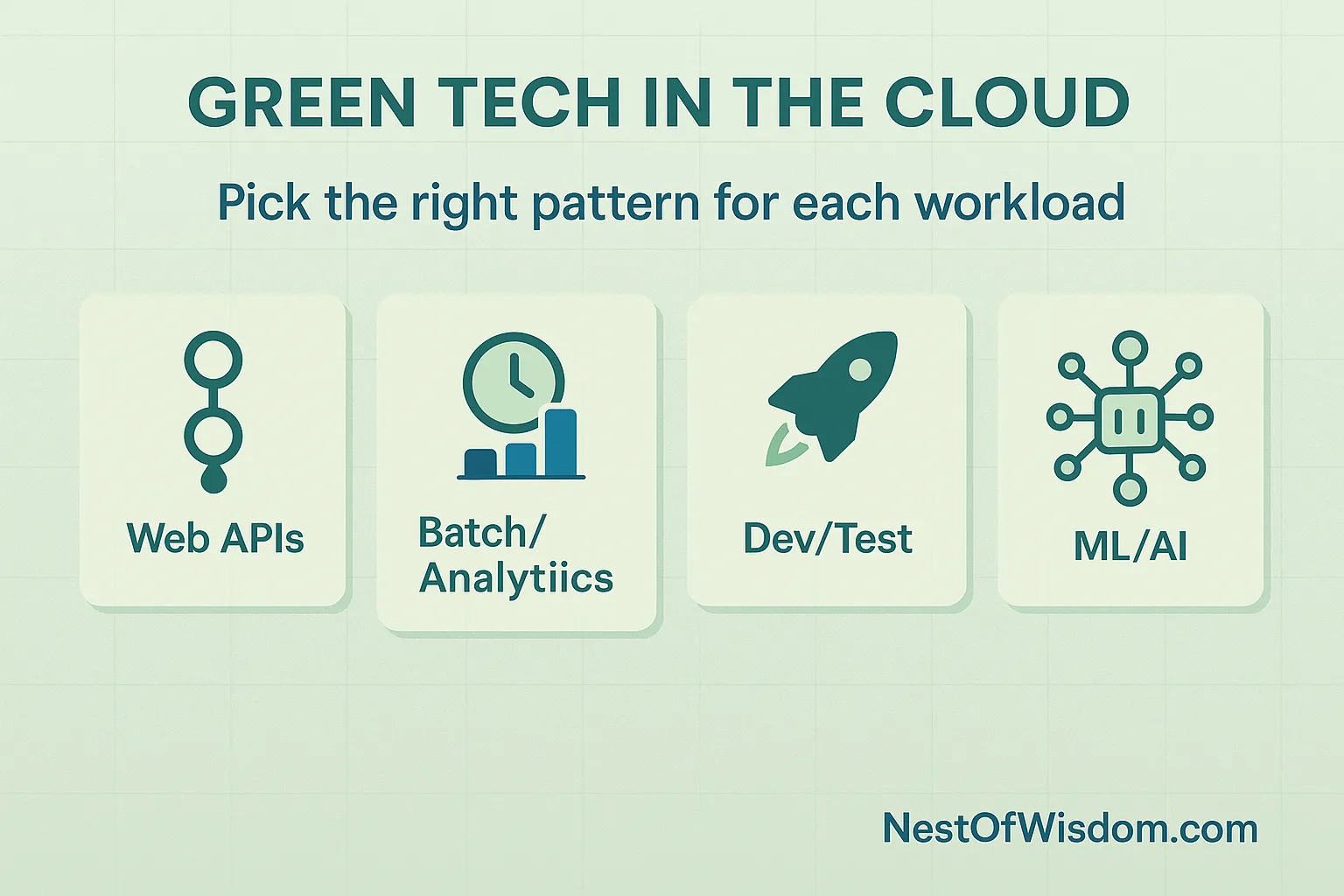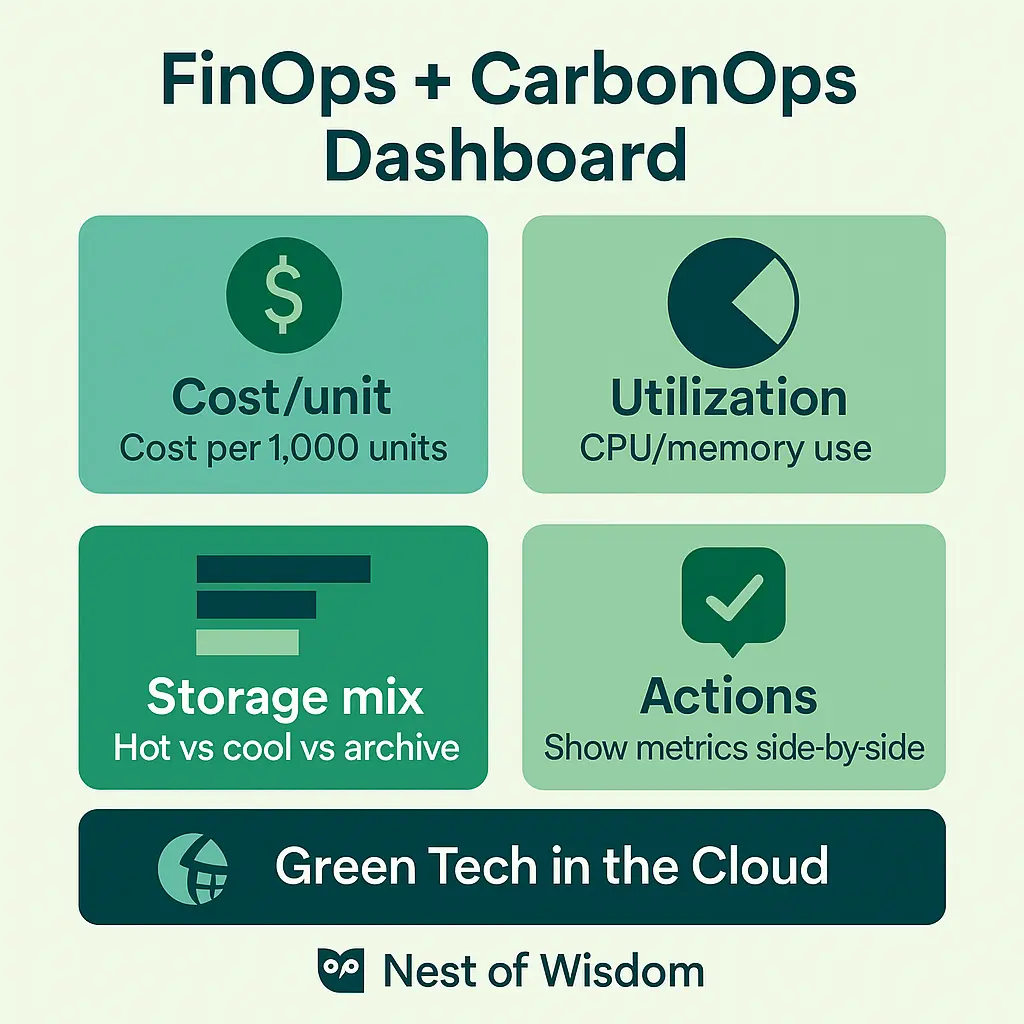Green Tech in the Cloud is more than a sustainability slogan—it’s a practical playbook to cut cost, reduce carbon, and simplify operations without sacrificing performance. This expanded guide turns intent into measurable outcomes with a clear 30-day rollout, proven workload patterns, team playbooks, and reporting language leadership will trust. “சூழல் நன்மையும் செலவு சேமிப்பும்—இரண்டும் ஒன்றாக நடக்கலாம்.”
Table of Contents
- Why Green Tech in the Cloud matters now
- 7 practical benefits of Green Tech in the Cloud
- Quick-start: the 30-day plan
- Rollout flowchart: who does what, when
- Workload patterns & right-sizing
- FinOps + CarbonOps: dashboards & ROI
- Governance & policy-safe language
- Architecture patterns that save cost & carbon
- Case snapshots
- What to measure & report
- Team playbooks (Ops, Data, Product, Finance)
- Common pitfalls (and quick fixes)
- Green Tech in the Cloud: FAQs
- Quick glossary
- Conclusion & next steps
- References
Why Green Tech in the Cloud matters now
Green Tech in the Cloud centralizes workloads on platforms with much higher utilization than typical on-premise estates. That aggregation—plus modern cooling, right-sized instances, serverless patterns, and large-scale renewable procurement—delivers lower energy per unit of compute and better economics. As AI/data grows, choices like region selection, storage lifecycle policies, and container autoscaling multiply the impact. Bottom line: lower cost, lower carbon, simpler operations.
It’s not a one-time campaign. A few hours on right-sizing, storage class adjustments, autoscaling, and removing “always-on” dev/test saves money immediately and keeps saving each month. When leadership asks for proof, built-in dashboards and exports make reporting straightforward. “அளவான வடிவமைப்பே சேமிப்பு.”
Related reads: Cloud Computing Benefits for Businesses, AI Copilots at Work, Cybersecurity in the Age of AI, Wearable Tech & Health Data.
7 practical benefits of Green Tech in the Cloud
- Lower energy per compute unit — Hyperscale efficiency and advanced cooling cut energy per transaction versus typical on-prem.
- On-demand scalability — Elastic services prevent over-provisioning; you use (and pay for) only what you need.
- Cleaner power mix — Selecting higher-CFE% regions for flexible workloads is a quick win with no code change.
- Built-in metering — Dashboards estimate emissions and track improvements; exports simplify ESG reporting.
- Operational simplicity — Managed databases/queues/analytics reduce “always-on” hours and failure modes.
- Cost & carbon together — Right-sizing, autoscaling, and lifecycle rules deliver savings and reduce waste.
- Stakeholder trust — Transparent, data-backed reporting builds confidence with customers and investors.
Quick-start: the 30-day plan
Use this sprint to operationalize Green Tech in the Cloud without boiling the ocean. Re-run quarterly.
Week 1 — Understand & baseline
- List top workloads: instance sizes, avg CPU/memory, storage class, region.
- Enable sustainability dashboards; export a baseline CSV (cost + emissions estimates).
- Tag resources (
env,team,owner) for accountability.
Week 2 — Right-size & autoscale
- Downsize under-utilized instances (CPU < 35% most of the time).
- Enable autoscaling and scheduled shutdowns for dev/test and batch nodes.
- Move infrequently accessed data to colder tiers; set lifecycle policies.
Week 3 — Regions & services
- Shift flexible batch jobs to higher-CFE% regions.
- Replace self-managed VMs with serverless/managed services where feasible.
- Adopt container autoscaling (HPA) with realistic requests/limits.
Week 4 — Report & lock in
- Export new dashboard numbers; compare with baseline to prove gains.
- Publish a one-pager: actions taken, savings, next steps.
- Codify wins into IaC/policies (tagging, right-sizing, lifecycle, region guardrails).


Rollout flowchart: who does what, when
Clarity beats ambition. This flow makes ownership explicit so the sprint doesn’t stall. “யார் என்ன செய்கிறார்கள்—தெளிவாக இருந்தால் வேகம் வரும்.”


Workload patterns & right-sizing
Apply the right pattern to each workload for fast, safe gains. These choices keep Green Tech in the Cloud practical.
- Steady Web APIs: Reserve base capacity; autoscale for peaks; choose higher-CFE% regions; add CDN/HTTP caching to cut compute per request.
- Batch & analytics: Schedule in greener regions/off-peak windows; use spot/interruptible where safe; separate raw vs. curated data; enforce lifecycle policies.
- Dev/Test: Auto-stop nights/weekends; use ephemeral preview environments; prune old environments; cut idle Kubernetes nodes.
- Data storage: Choose the right class; compress; deduplicate; lifecycle to cool/archive; delete temp staging by default.
- ML/AI: Prefer managed training with job-level scheduling; choose instances with higher performance-per-watt; checkpoint to cold storage between sprints.


FinOps + CarbonOps: dashboards & ROI
Finance cares about dollars; sustainability cares about emissions. Track a few metrics together and report them side-by-side. In Green Tech in the Cloud programs, this transparency builds trust and unlocks budget for automation.
- Unit economics: Cost per 1,000 requests, per GB processed, or per training hour.
- Utilization trend: CPU/memory over time—reduce long “flat” lines at 5–10%.
- Storage mix: Hot vs. cool vs. archive with targets (e.g., 30% data in cool/colder tiers).
- Region mix: Shift at least one batch pipeline to a higher-CFE% region; quantify via dashboard exports.


Governance & policy-safe language
Keep claims credible and educational so they stand up to scrutiny.
- Do say: “can reduce footprint,” “helps estimate emissions,” “supports reporting.”
- Don’t claim: “zero emissions now,” “guaranteed reductions,” or unverified outcomes.
- Include proofs: dashboard snapshots, ESG exports, utilization charts, before/after storage tiering.
Simple policy template: tags required; autoscaling for eligible services; lifecycle for non-hot data; quarterly right-sizing reviews; regional guardrails for batch; IaC checks that block non-compliant resources during CI.
Architecture patterns that save cost & carbon
- Event-driven vs. polling: Replace tight-loop polling with events/queues to slash idle compute.
- Caching tiers: CDN + edge caching + application cache lower origin compute and egress.
- Async pipelines: Split hot/critical vs. warm/async stages; run warm stages in greener regions at off-peak times.
- Right protocol & formats: HTTP/2 or HTTP/3 + compression; columnar formats (Parquet/ORC) for analytics.
- Data lifecycle by design: Put TTLs on object prefixes and temp workspaces; surface deletion in dashboards.
“அவசியமில்லாத ஓட்டத்தை நிறுத்தினால்—செலவும் கார்பனும் குறையும்.”
Case snapshots
Snapshot A — Retail SMB (Web + analytics)
- Downsize two over-provisioned web nodes; add HPA for spikes.
- Shift nightly ETL to a greener region and off-peak window.
- Enable S3/Blob lifecycle rules (30 → 90 → Archive).
Result: ~18–25% monthly cost reduction plus a measurable drop in dashboard emissions estimates over 60 days.
Snapshot B — Marketing team (campaign analytics)
- Move from always-on VMs to scheduled serverless jobs.
- Compress/deduplicate data; prune non-actionable event fields.
- Autoscale event processing with queue thresholds.
Result: Smoother peaks, less idle time, and clearer reporting for leadership.
What to measure & report
- Identity & change control: % tagged resources; % of changes via IaC vs. console.
- Right-sizing index: % instances < 35% avg CPU moved down within 30 days.
- Storage lifecycle coverage: % of buckets with lifecycle rules; GB shifted to cool/archive.
- Region mix shift: # of flexible jobs executing in higher-CFE% regions.
- Cost + carbon trend: Unit cost and estimated emissions trend lines (monthly).
Leaders don’t need product names; they need evidence that risk and waste trend down while reliability holds. Green Tech in the Cloud makes those trends visible.
Team playbooks (Ops, Data, Product, Finance)
Ops (Week 1–2)
- Turn on autoscaling; enforce off-hours shutdowns for dev/test.
- Add IaC policy checks for tags, lifecycle, and instance families.
Data/Analytics (Week 2–3)
- Partition data; convert to columnar; tier older partitions automatically.
- Schedule batch in greener regions; adopt spot/interruptible carefully.
Product/Engineering (Week 3–4)
- Add caching; move chatty workloads to event-driven patterns.
- Introduce preview environments with auto-TTL.
Finance/FinOps (Monthly)
- Publish one-pager: unit economics + storage mix + region mix.
- Track realized vs. planned savings; reinvest a portion into automation.
“ஒன்றிணைந்த அணிகள்—விரைவான பலன்.”
Common pitfalls (and quick fixes)
- Only chasing discounts: Commitments can lock in over-provisioning. Fix right-sizing first, then commit.
- Ignoring storage: Hot storage hoarding is expensive. Classify, compress, deduplicate, and lifecycle aggressively.
- Forgetting dev/test: Idle nights/weekends burn money. Enforce schedules and auto-stop.
- No owner tags: Without
ownerandteamtags, waste persists. Make tags mandatory. - One-time cleanup: Without policy + automation, waste creeps back. Bake rules into IaC and scan continuously.
Green Tech in the Cloud: FAQs
1) Is Green Tech in the Cloud more expensive?
Usually not. Efficiency, right-sizing, caching, and serverless patterns often reduce total cost while shrinking emissions estimates.
2) Can small teams benefit quickly?
Yes. Start with tags, autoscaling, lifecycle rules, and shifting one flexible batch pipeline to a higher-CFE% region.
3) How do we measure impact credibly?
Use provider dashboards and export CSVs monthly. Show utilization, storage tiering, region mix, and unit economics. Keep language educational; avoid absolute claims.
4) Do we need to move everything to serverless?
No. Serverless helps for spiky/event-driven workloads, but steady workloads may be cheaper on reserved/committed instances once right-sized.
5) What if legal/compliance limits regions?
Prioritize right-sizing, lifecycle, caching, and managed services within allowed regions. You’ll still capture meaningful improvements with Green Tech in the Cloud practices.
Quick glossary
- CFE% (Carbon-Free Energy Percentage): Share of electricity in a region from carbon-free sources.
- Right-sizing: Matching instance size/count to actual usage.
- Lifecycle policy: Automatic tiering/retention rules for data.
- HPA: Kubernetes Horizontal Pod Autoscaler scales pods based on metrics.
- FinOps: Cloud financial management practices.
Conclusion & next steps
Green Tech in the Cloud lets you cut cost and carbon together—fast. Start with the 30-day sprint: baseline, right-size, choose greener regions, and lock policies via tags and lifecycle rules. Report results simply and repeat quarterly. Standardizing these practices builds credibility with leadership while delivering real savings. “செயலில் வைத்தால்—பலன் உறுதி.”
Bonus: Deepfake-fraud verification for finance teams
Voice cloning and AI-authored emails increase payment fraud risk. Add a simple verification flow (call back a known number, require dual approval) to your runbook. It complements Green Tech in the Cloud savings by protecting the cash those savings create.
References
- IEA overview: Data Centres & Data Transmission Networks
- Microsoft: Emissions Impact Dashboard
- Google: 24/7 Carbon-Free Energy & Regional CFE%
- AWS: The Climate Pledge
Nest of Wisdom Insights is a dedicated editorial team focused on sharing timeless wisdom, natural healing remedies, spiritual practices, and practical life strategies. Our mission is to empower readers with trustworthy, well-researched guidance rooted in both Tamil culture and modern science.
இயற்கை வாழ்வு மற்றும் ஆன்மிகம் சார்ந்த அறிவு அனைவருக்கும் பயனளிக்க வேண்டும் என்பதே எங்கள் நோக்கம்.
- Nest of Wisdom Authorhttps://nestofwisdom.com/author/varakulangmail-com/
- Nest of Wisdom Authorhttps://nestofwisdom.com/author/varakulangmail-com/
- Nest of Wisdom Authorhttps://nestofwisdom.com/author/varakulangmail-com/
- Nest of Wisdom Authorhttps://nestofwisdom.com/author/varakulangmail-com/
Related posts
Today's pick
Recent Posts
- Internal Linking Strategy for Blogs: A Practical, Human-Centered Playbook
- AI in the Automotive Industry: A Practical, Human-Centered Guide
- Cloud Tools for Small Businesses and Freelancers: The Complete Guide
- Generative AI in Business: Real-World Use Cases, Benefits & Risks
- 7 Life-Changing Daily Habits for Weight Loss Without Dieting

